By Jean Andrews
Physics & Astronomy
Ohio University alum Dr. Jack Steiner (B.S. HTC Astrophysics, B.S. Applied Mathematics, 2006) has been named an Einstein Postdoctoral Fellow. This program, sponsored by the National Aeronautics and Space Administration (NASA) and administered by the Chandra X-Ray Center (CXC), is focused on research in high energy astrophysics. The fellowship provides support for up to three years at an annual stipend of $67,000, plus research funding.
“These three-year fellowships are probably the most prestigious postdoctoral fellowships in astrophysics,” says Dr. Markus Boettcher, Adjunct Professor of Physics & Astronomy and Professor at the Center for Space Research at North-West University in Potchefstroom, South Africa.
“Fourteen fellows were selected out of a pool of 148 applicants from all over the world, proposing research in all areas of astrophysics relevant to NASA’s Physics of the Cosmos program. It’s a remarkable achievement,” Boettcher said.
Currently, Steiner is a Hubble Postdoctoral Fellow at the Harvard-Smithsonian Center for Astrophysics and plans to use his fellowship to continue his study on the characterization—in particular, spin measurements—of Galactic black holes, at the Massachusetts Institute of Technology, which will serve as his host institution.
Steiner views the Einstein Fellowship as a tremendous opportunity.
“It allows me almost complete autonomy and provides me the means to pursue my research interests. This includes being able to work with any persons or groups. I have a research supervisor, who acts as a mentor. At the same time, I don’t have a ‘boss’ who would typically expect me pursue his or her own interests, which may not be exactly my own. So I am really able to act as my own boss, and with an experienced mentor who will help me to most effectively pursue my interests,” he says.
Steiner’s principal mentor in astrophysics has been his doctoral adviser, Jeffrey McClintock, a senior astrophysicist at the Smithsonian Astrophysical Observatory. “One of Jeff’s best qualities,” says Steiner of his mentor, “is his gift for infecting others with his endless enthusiasm for science.”
From OHIO Undergrad to Spinning Black Holes Expert
Steiner’s undergraduate thesis advisor at OHIO, astrophysicist Brian McNamara recalls Steiner as an excellent student for many reasons.
“I got to know Jack when I was teaching physics at Ohio University. Teaching smart students individually was a joy. The Honors Tutorial College students were as strong as you will find anywhere. Jack stood out from the bunch in many ways. Yes he is very smart. We all knew that. But he was also one of the kindest and most considerate students I’ve known. It’s been awhile and memories fail, but I recall his problem set solutions could double as answer keys. They were nearly perfect.”
“Jack would often stop by my office, always with a big smile and a ‘hey!’ sit down and shoot the breeze,” McNamara says. “Sometimes we’d talk science but often politics. He’s liberal, like me, and we both were struggling through the Bush years. So we would often lament the state of the union. He did a senior project with me dealing with infrared observations of galaxies obtained with OHIO’s telescope at Kitt Peak in Arizona. He made the observations and did an excellent job analyzing them. With a bit more effort it could have been published. But Jack went off to Harvard to work on black holes with Jeff McClintock, an old friend of mine, and I figured that work was far more important.”
McNamara came to OHIO from the Harvard-Smithsonian Center for Astrophysics and continues to hold an appointment there. “I run into Jack there, usually talking to Jeff about the black holes. I’m off to the Lorentz Center at Leiden … to speak about black holes, and Jack will be there, too. He’ll be the same but different. When I see him his big smile will appear, and I’ll get a ‘Hey! How ya doing?’ But now it’s Dr. Jack Steiner, one of the world’s experts on spinning black holes,” McNamara says.
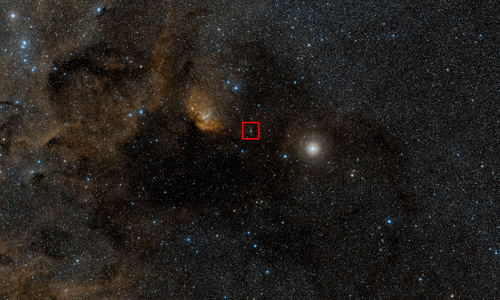
An optical view of Cygnus X-1 in the Milky Way Galaxy is an example of one of many black holes Steiner and other astronomers study. Source:DSS
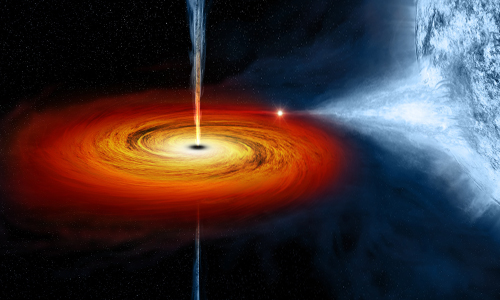
An artist’s illustration depicts what astronomers think is happening within the Cygnus X-1 system. Cygnus X-1 is a so-called stellar-mass black hole, a class of black holes that comes from the collapse of a massive star. The black hole pulls material from a massive, blue companion star toward it. This material forms a disk (shown in red and orange) that rotates around the black hole before falling into it or being redirected away from the black hole in the form of powerful jets. Illustration: NASA/CXC/M. Weiss
In the Q&A below with Jean Andrews, Special Projects Assistant in Physics & Astronomy, Steiner described his undergraduate years, his experiences in graduate school at Harvard University, his postdoctoral position as a Hubble Fellow at the Harvard-Smithsonian Center for Astrophysics, and his plans for research while an Einstein Fellow.
Dusk to Dawn: A Discussion with Jack Steiner
Andrews: Where did you grow up?
Steiner: I grew up in Maumee, a suburb of Toledo, and attended Maumee High School.
When did you first start to be interested in physics?
It was actually at Maumee High School, where I first got the bug for physics. Although math and science had been my natural proclivities, in high school I had an amazing teacher, Matthew Dick. He is one of those rare and amazing teachers, capable of inspiring and leading effectively, while still relating to the kids. My physics class was especially tight knit, likely because a large number of us were guinea pigs and had signed up for an additional college-prep course (AP electricity and magnetism) that he developed with our year.
What was it like as a little boy growing up and the sense when you discovered your love for astronomy?
Like many kids, for me it began with a fascination with the night sky, studying the constellations and planets. The Ritter Planetarium at the University of Toledo was relatively close to home, and I loved when my parents brought me to their shows. At the same time, this interest was mingled with many others. The spark that kindled my interest in pursuing astronomy was midway through my program at OU when I took an overview astronomy course designed for physics graduate and undergrad students, taught by Brian McNamara. I was totally caught up in it, and felt it played the keys of what I loved about physics while being geared towards my interest in the philosophical.
Was there someone who mentored you towards a love of mathematics, or physics, or astrophysics?
I have been very fortunate in my life to have a string of mentors who have fostered this in me. First and foremost is my father, a physician who is by passion a mathematician. Dad has pursued number theory in his spare time since before I was born, and in addition to sharing this interest with me, would tell me stories of young Gauss or Archimedes when I was growing up. Next to my father, certainly the most formative mentor has been my Ph.D. adviser Jeff McClintock, a true paragon of an astronomer. One of Jeff’s best qualities is his gift for infecting others with his endless enthusiasm (for science).
Could you give an example?
I’ll tell you my very first encounter with Jeff: I went to grad school interested in many topics, but fully determined to work on studying planets (especially those outside the solar system, “exoplanets”). Toward the end of my first semester, I got an email from Jeff, indicating that he was looking for students and asking if I was interested in talking about his work. I had seen him speak on black holes at a colloquium, and it was exciting, but was also not part of my “plan.” So I wrote him back politely to say thank you, but that I wasn’t going to work on black holes, and to wish him luck since I was going to work on planets. Jeff said that was fine and asked me to stop by to chat science anyhow. I certainly couldn’t turn that down. So I came by and we ended up chatting for perhaps four hours. At the end, I was completely jazzed about Jeff’s program, and all the new questions I had about black holes. And I knew Jeff was a guy I’d like to work for.
Why did you choose to attend Ohio University?
A major factor for me was the Honors Tutorial College. But also important were my impression of the physics department and its sense of community, and my impression of the broader student body.
What do you remember when you first came to Athens?
I was really drawn to the natural beauty of Athens and of Hocking Hills on the trip there. I also remember my feeling that the students seemed much happier at OHIO compared to other schools I had been visiting.
What do you remember about your time as an undergraduate?
I used to love to escape to Stroud’s Run State Park in the spring and summertime. But most of my memories aside from physics were focused on friends and student groups. I was involved in College Democrats and also human rights groups like ONE, a gay-straight alliance. Many of my lasting friendships and favorite memories come from either the department or else from those groups.
Could you share a memory while you were in our department?
A really notable experience for me was Thomas Statler’s observational astronomy class. This was something like a boot camp for aspiring observational astronomers. And now that I know a bit more, I can more fully appreciate all that Tom did in developing such an extraordinary class. It was very intense, and required us to design and carry out a science project using a sophisticated rig for an amateur-class telescope. As students, we observed together in groups overnight from dusk to dawn, when the weather allowed. It was exhausting but great fun. It was very challenging and likely because of this we bonded. Some of my closest friendships first formed in that class.
What was it like studying with Dr. McNamara?
Brian was a wonderful adviser. He connected me with his graduate students, and they really welcomed me into the team. I learned a tremendous amount in terms of how to conduct research in astronomy and analyze data. Though the coursework had paved the way, this is something like learning to play baseball if you’ve simply been an avid fan of watching the game; knowing the rules and procedures will help, but the practical skills for being in the “field” are distinct. Brian took me observing to MDM with his graduate students Laura Birzan Rafferty (Ph.D., 2007) and David Rafferty (Ph.D., 2007); it was a defining experience.
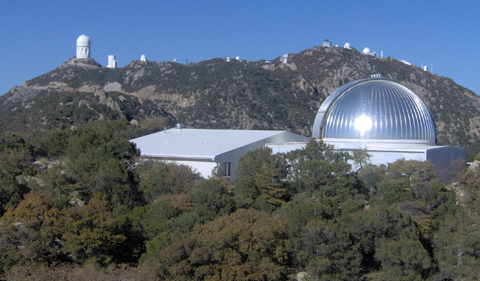
The MDM Observatory on Kitt Peak in Arizona is owned and operated by a consortium of five universities – Dartmouth College, The Ohio State University, Columbia University, The University of Michigan, and Ohio University.
Did you go to MDM or elsewhere to do your senior thesis research?
I did my senior thesis research on the Hiltner 2.4m. The hands-on experience there is really something. While I’ve used larger telescopes since, I’ve never had an experience that compares in terms of really having full control in the “driver’s seat” with a premier instrument. Those observing runs were thrilling, and I savored them completely.
One highlight was at the end of my observing run when I had about 20 minutes before sunrise and was free of all duties. I turned the telescope to a particular galaxy that had fascinated me (M87). This galaxy at its core has one of the most impressive and well-studied jets on all the sky. (A jet is a sort of explosion, in this case emerging close to the speed of light in narrow beams from a supermassive black hole.) Unlike the classic and romantic image of the eyepiece, this work is done using an advanced digital camera (the big brother of the one on a cell phone). I used the camera and telescope to image this galaxy and then played with the data as it came out. That jet lept out at me on the screen. I can’t say why exactly, but it was a powerful experience for that image to have been mine!
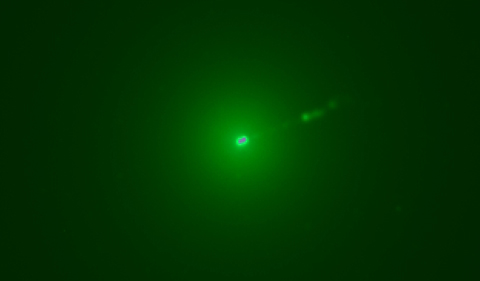
The elliptical galaxy M87, imaged by the Hilter 2.4m telescope at MDM Observatory. The bright stream emanating from the center is a jet being launched by a supermassive black hole at M87’s core. Image by Jack Steiner
Could you share an anecdote about working with an HTC faculty tutor?
Saw (Dr. Saw-Wai Hla) and I would write out notes together during each session, which was a unique and helpful technique of his. He was the one who first brought me into research, and our tutorial led to me working in his lab starting the following semester. Through that, I traveled with Saw and his group to my first conference, an AVS (American Vacuum Society) meeting in Baltimore. I learned a lot from that trip, about how experts interact, and what made an effective short research talk, and what didn’t. On a more personal note, I distinctly remember a dinner from the conference with Saw and a German colleague, in which Saw told us about growing up in Burma and his time in business harvesting teak trees. Saw said they would transport the trees down from mountains by floating them down streams running down the mountainside. To guide the trees down, they would hire elephants who would slide down the mountain in the streams with these trees. That picture has stuck with me!
What was a challenge you faced while an undergraduate?
The summer I started research with Brian, the timing turned out to be quite poor. Brian wanted me to start at one time, but for reasons I don’t recall, it had to be another. The upshot was that Brian and his group were traveling for two weeks while I was beginning my research. I had never coded in Linux or Unix before — and these are fairly ubiquitous for astronomy. On top of this, I had to learn a new programming language as well. For two weeks, I toiled away with program manuals, working to hack around with some homegrown software, and gradually learned my way around.
I pushed through, and along the way ended up getting to know some of the other grad students in the department as I tried to navigate the problem, toiling away in the computer lab. It was in some ways analogous to a sort of “immersion” experience to learn a language. At the end of those two weeks, when Brian came back, he was able in minutes to clear away some of the many briars I had entangled in. But it was in the end was an effective, though perhaps not the most efficient, way to learn.
What circumstances in your life helped you along your career path?
Certainly my family has been a bastion of support. In my childhood, my parents encouraged creative outlets including music, acting, painting, pottery, just as much as science or math. Creativity is enormously underestimated in popular perception of the pursuit of science. In reality, this plays a big role in our endeavors. Whether dealing with quarks or quasars, one is dealing with phenomena far from everyday experience and trying to discern fundamental properties of our universe through extraordinary means.
On a more practical note, I was very fortunate in having opportunity to work in a number of research groups during my undergraduate career. I’ve already mentioned my research in the department with Saw and Brian, but I also worked over a summer in an REU program with Larry Curtis at the University of Toledo doing atomic physics and worked at the Voinovich Center with Valerie Young in atmospheric chemistry. These experiences not only greatly enriched my science proficiency, but also helped illuminate my interests, and showed me through example what qualities and practices go along with being a mentor and a scientist.
What are some of the qualities and/or practices you were shown while an REU intern with Larry Curtis?
Larry was a great mentor, cut from the same cloth as Jeff. From Larry I learned a great deal about both atomic physics (this sub-discipline of physics is very useful for astronomy, where often we discern the properties of an environment like its composition, temperature, or density, all while using atomic features as diagnostics). Moreover, from the get-go, Larry treated me like a junior colleague rather than as subordinate, if that distinction makes sense. Larry and I wrote my first paper together, and he really shepherded me through that process. Along the way, he taught me a great deal about writing, refereeing, and simply being a scientist in academia. As I have now started working with students, I find I often think of Jeff, Larry, and Brian in particular as examples to guide how I would like to act as a mentor.
In what ways did working with Valerie Young in atmospheric chemistry enrich your science proficiency?
From Valerie I learned a great deal about laboratory work and also engaging in a science domain touching on public policy, which I found quite rewarding as a motivation. (Our work was related to air quality and discerning wind transport and seasonal variation in various chemicals.) Valerie in particular guided me in statistical thinking and methodology. As any scientist will tell you, a measurement is meaningless without its uncertainty, and she helped me to understand and appreciate statistics as a sort of language for communicating about data.
Did you ever consider being something other than an astrophysicist?
Absolutely. I was really interested in chemical engineering for a time, laboratory physics, and even social psychology. But I would say nothing really has resonated with me in the way that astronomy/astrophysics does.
In what ways did the HTC program prepare you for graduate school?
There are two aspects which spring to mind in particular: (1) HTC’s structure demanded and helped to instill an independent and self-paced style of work. This ethic really helped in grad school, which is a self-driven enterprise. And (2) HTC opened the doors that led to my getting involved in research. Research, ultimately, is what grad school (and a career) in astronomy is centered upon.
Although this is tertiary compared to those two, HTC helped me find confidence and particularly familiarity in interacting with faculty, to help facilitate discussion which is necessary for engaged learning.
From OHIO to Harvard University
What was it like to move from rural Appalachian Ohio to Boston for graduate school?
The shift certainly jolted us in a number of ways, mostly in cost of living. But I’m from outside of Toledo — an intermediate-sized city — and so the rural to urban segue wasn’t as abrupt as it might have been for others.
Is there anything you wished you had known before you moved there?
Absolutely! I had many misconceptions about grad school going in. A notable one is that I expected grad school to be a sort of narrowly focused extension of the undergrad experience. But this is not the case: at least for astronomy, research is paramount and the course work is a necessary incidental in place to enable the research to thrive. On a practical level, in hindsight I see at least a handful of courses that I wish I had taken as an undergrad, practical ones mostly related to programming or mathematics because these are so important in the mechanics of carrying out research.
What was it like to be a graduate student at Harvard?
It was a great experience. Because the Harvard department is combined with the Smithsonian Institute’s observatory at the Center for Astrophysics (CfA), the scientist-to-student ratio is actually inverted compared to most departments. Especially for students interested in working on observations like me (as opposed to theory), this means there is an abundance of opportunity, and actually an overabundance of projects and potential advisers around. Usually demand tends to go in the other direction.
What advice would you have for current undergraduate astrophysics majors about studying in the field?
To get involved in research! There is no better way to pave the way towards your own success and growth as a scientist — or to find out what doing astronomy is all about — than to get involved in a research project. I would also say that the most important decision along the way is who to choose for an adviser. My adviser in grad school at the CfA, Jeff McClintock, is simply the finest scientist and person I know. In Jeff, I found an incredible mentor and friend, and he has been my strongest advocate and has encouraged me tremendously. Having a positive relationship with the person you will effectively apprentice with is critical to thriving while learning the ropes.
Can you describe what it’s like to work at the Harvard-Smithsonian Center for Astrophysics (CfA)?
I don’t know of another place like it. Its best and worst attribute is its size. The place is simply teeming with astronomers of every sub-discipline. This means no matter what topic, software, technique, or object you are interested in, you will find at least an expert or two at the CfA. But the flip side to this coin is that it is simply impossible to keep up with all the activities and talks going on — or in fact, all the people at the CfA. On the whole though, an overabundance of experts is a pretty good problem to have.
Post Doc in Cambridge (England): A Mecca for Academics
What was the best thing about being a postdoctoral associate at the University of Cambridge?
Well, the best thing about any place I’ve been is really the people. But that’s too trite a response. To an American, Cambridge is firstly ancient and also stunningly beautiful. The oldest building in the town center dates back nearly a millennium; and for many centuries the university grew, was fueled by the riches of various kings, queens, and elites to a kind of Castellan grandeur that just doesn’t exist here in the States.
The town has the feel of a kind of Mecca for academics; it is grand and ornate, teeming with scholarship of every variety, but at the same time, it’s a small town. For instance, outside my office window was a pasture usually filled with a dozen cows, and yet, down the road a mile or so was King’s College, which looked for all purposes like a palace. In this way it was a superposition of qualities at odds with one another. I really loved the place. The Institute of Astronomy (IoA) does a lot of things just perfectly. It’s a large institution, and every day most folks congregate twice, for coffee in the morning and tea in the afternoon. This fosters a kind of camaraderie and interchange of ideas that is rare, especially for a place of its size.
At the end of the day though, the best part for me was certainly my colleagues who became friends from that time. I work with and regularly connect with many folks from that period, including my former boss Andy Fabian, who was simply great. Andy is somehow very present in all of the hundred projects he maintains all at once, and I was fortunate to be a part of his group.
Mind-Warping Black Hole Science
What’s something you find fascinating about stellar-mass black holes?
There are many things that are mind warping about black holes. One of the most striking is that they are actually incredibly simple! Unlike everything else in the universe, a black hole in nature is at once unique, while being fully describable by just two numbers — its mass and spin. This is similar to the simplicity of “fundamental” particles such as the electron, and yet no two black holes are the same. Nothing we encounter in daily life in nature comes close to this elegant simplicity.
Have you and your colleagues determined how to measure the spins?
It was others who first pioneered the methods of measuring spin, but my colleagues and I have been working hard to hone these techniques to great precision and to apply them broadly. While the honing step is an iterative process, which is by no means complete, we have made great progress and — critically — have a pretty good handle on the (systematic) errors for those aspects we are still working to improve. Our technique is powerful in that it relies on a fundamental and simple feature of general relativity: the relationship between spin and the radius of the inner-edge of the accretion disk around a black hole. By measuring the radius of that edge, typically just a few hundred miles from the black hole’s center, we constrain its spin.
Why is it important to study spins and jets?
Black holes are a fundamental mystery of nature; they are the ultimate of general relativity. Philosophically troublingly, the event horizon of a black hole is the boundary of not just what is known but of what is knowable. (We simply can’t recover information from inside the horizon.) Black holes are the death remnants of the most massive stars and their largest manifestations. “Supermassive” black holes live in the centers of galaxies, including our own. Black holes produce the most powerful explosions since the Big Bang (i.e., their jets).
Through the jets, the growth of these supermassive black holes is linked to the formation of stars and growth of a host galaxy, and indeed this activity over cosmic time has carved the evolution of stars in our universe. We can only understand black holes by measuring their two inherent properties — mass and spin, and by studying their behavior which is most pronounced in their jets. Understanding the connection between spin and jet production remains one of the forefront questions in black hole science and bears on these many fundamental questions pervading the larger domain of astrophysics.
A Black Hole “Gallup poll”
What are you looking forward to in the next three years in terms of studying spin?
Right now we have a smattering of spin measurements, but we aren’t quite at the point of having a quorum for a statistically useful sample. We really want to be able to perform a “Gallup poll” of black hole demographics to help us understand their behavior and range as a class of objects. I’m excited about the prospect of establishing this critical sample size and employing it to learn how black holes form, how they grow and evolve. Spin and mass are the two characteristics on which these traits imprint. It’s hard to say exactly what we’ll know in three years that we don’t know now, but this is the motivation guiding our steps forward.
Do you see your present research going in a different direction in the next few years?
I’m drawn to so many fun and interesting ideas that it’s hard to forecast the road ahead through a landscape of fascinating questions. Often the exploration opens up new paths. But lately I’ve been thinking a lot about collisions between black holes and other bodies in space, which must occur in our vast universe, and may produce some strange phenomena.


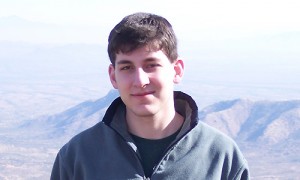
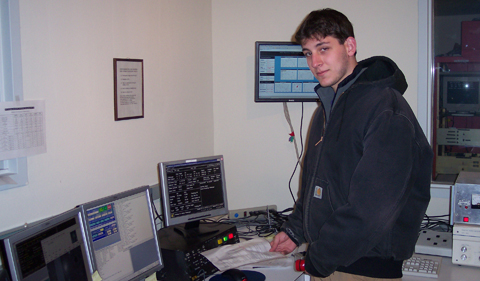


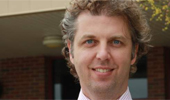
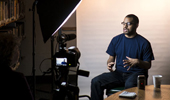













Comments